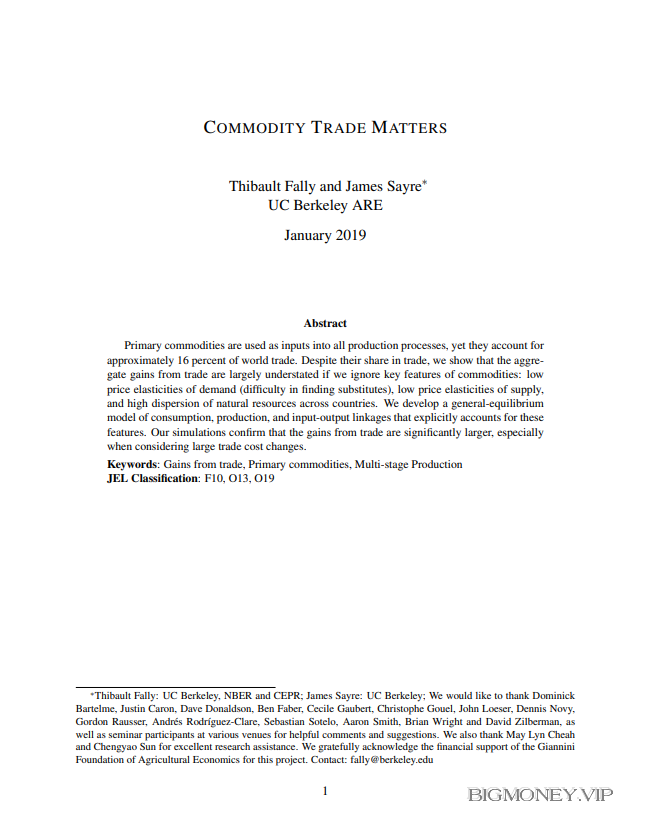COMMODITY TRADE MATTERS Thibault Fally and James Sayre

1 Introduction
A continued concern associated with globalization is the access of countries to critical commodi-
ties in the world market. Pressing issues such as geopolitical instability combined with increased
openness and a burgeoning demand for critical minerals used in new technologies have made un-
derstanding the role of international commodity trade even more important today. Quantifying the
interdependency of nations on trade in natural resources has crucial implications for international
relationships, such as the risk countries face due to instability in access to global markets, as well
as how much countries would lose by imposing barriers to trade, such as the creation of tariffs on
imported commodities or by cutting off a key trading partner.
Despite recognition among academics of the importance of international trade, several recent
papers have found that the welfare gains from international trade are modest: using a formula pro-
posed by Arkolakis et al. (2012) that applies to a wide range of models, estimates of the gains from
trade equal 1.4% of GDP for the US in 2000.1 These models, however, make stark assumptions
that do not fit stylized facts about most primary commodities. Commodities are characterized by
several traits, which include: low responsiveness of both demand and supply to changes in price,
reliance on natural resources, and a high concentration of these natural resources among only a
few countries (e.g. Chile for copper, South Africa for platinum, Congo for cobalt). As shown in
previous work (see Gilbert 2010, Wright 2011), these features can explain the high volatility of the
price of these commodities. But little research has yet been undertaken to examine the implications
of these features for the quantification of the gains from trade.
The idea motivating this paper can be simply illustrated using a textbook two-commodity dia-
gram for the gains from trade, as shown in Figure 1. Conditional on the same values of observed
production E and consumption C, the gains from trade depend upon the shapes of the isoquant2
and the production possibility frontier (PPF). In the left panel (a), demand and production can ad-
just flexibly to changes in relative prices, whereas in the right panel (b), both the isoquant and PPF
are more convex (inelastic). We argue that trade with commodities corresponds to the case of in-
elastic supply and demand, where the gains from trade are the largest. Furthermore, as commodity
production tends to be concentrated among few countries, this leads to larger differences between
demand C and production E, and thus larger implied gains from trade.
We embed such channels and quantify the gains from trade in an otherwise standard model
with gravity equations for international trade in each final good and primary commodity. To do so,
we proceed in three steps. First, we assemble a rich dataset on trade, production, and prices across
169 detailed commodities with which we document several stylized facts on trade in primary com-
modities. Next, we develop a general-equilibrium model of trade that accounts for these specific
features and stylized facts. Finally, we use our model and data to simulate counterfactual equilibria
with higher trade barriers and confirm that ignoring these specific features of commodities leads to
a wide understatement of the gains from trade.
In order to assess the gains from trade, an essential step is to assemble and harmonize trade and
production data at a disaggregated level. Current datasets of trade and production generally aggre-
gate commodities into broad categories, such as “minerals”. This level of aggregation is not able
to account for the input-output linkages found in commodity trade. For instance, although many
countries produce mineral commodities broadly, the production of specific minerals is highly dis-
persed across countries. To capture this level of granularity, we use detailed data on production in
order to match the trade data available across 6-digit or 4-digit HS product categories. As there is
no readily-available dataset at a such a disaggregated level spanning many commodities, produc-
tion and price data are gathered from various sources. We then document several stylized facts that
describe trade in commodities: the concentration of trade and income in a few commodities and
countries, the low elasticities of supply and demand from our own meta-analysis covering many
scattered sources, and the responsiveness of trade in commodities to trade barriers. These features
help justify the assumptions of our model and explain the large gains from trade in commodities.
Our model includes multiple (traded) sectors, two stages of production (final goods and com-
modities) and different factors of production (labor and natural resources). The




